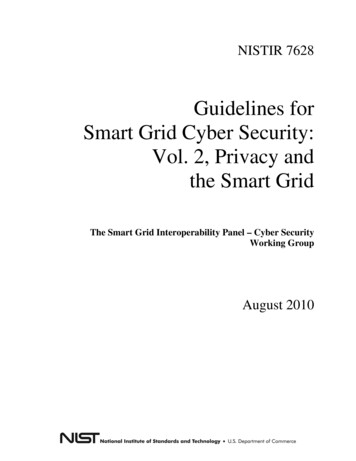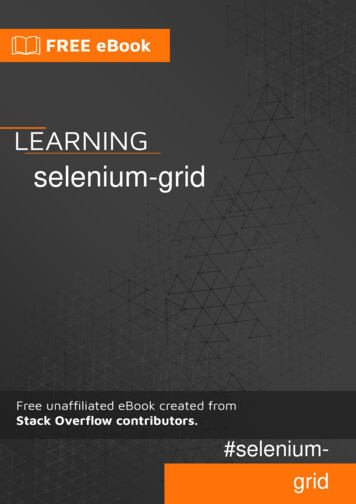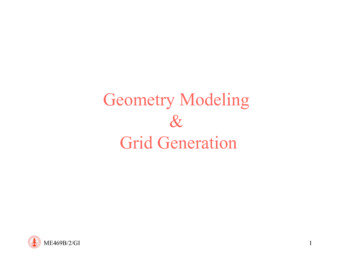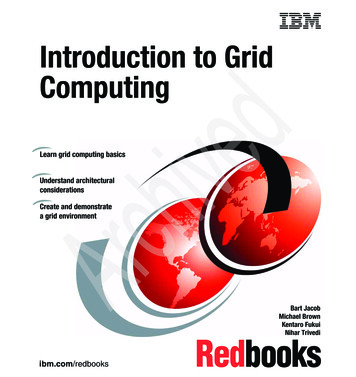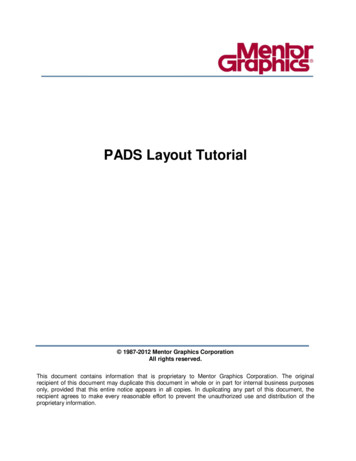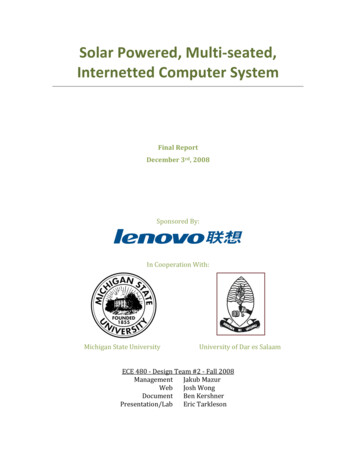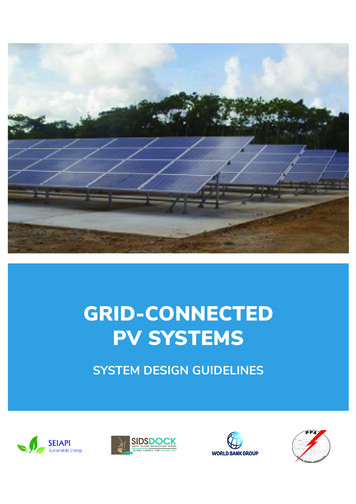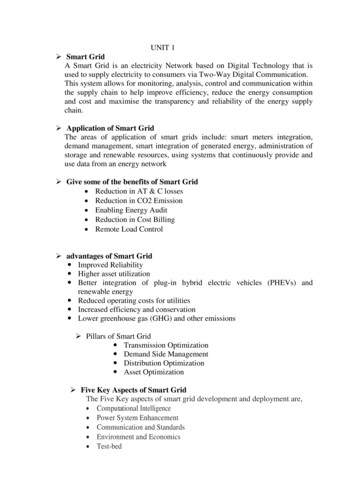
Transcription
UNIT 1 Smart GridA Smart Grid is an electricity Network based on Digital Technology that isused to supply electricity to consumers via Two-Way Digital Communication.This system allows for monitoring, analysis, control and communication withinthe supply chain to help improve efficiency, reduce the energy consumptionand cost and maximise the transparency and reliability of the energy supplychain. Application of Smart GridThe areas of application of smart grids include: smart meters integration,demand management, smart integration of generated energy, administration ofstorage and renewable resources, using systems that continuously provide anduse data from an energy network Give some of the benefits of Smart Grid Reduction in AT & C losses Reduction in CO2 Emission Enabling Energy Audit Reduction in Cost Billing Remote Load Control advantages of Smart Grid Improved Reliability Higher asset utilization Better integration of plug-in hybrid electric vehicles (PHEVs) andrenewable energy Reduced operating costs for utilities Increased efficiency and conservation Lower greenhouse gas (GHG) and other emissions Pillars of Smart Grid Transmission Optimization Demand Side Management Distribution Optimization Asset Optimization Five Key Aspects of Smart GridThe Five Key aspects of smart grid development and deployment are, Computational Intelligence Power System Enhancement Communication and Standards Environment and Economics Test-bed
Features of Smart GridReliabilityFlexibility in TopologyEfficiencyPlatform for advanced services some of the challenges faced presently by the Indian ElectricitySystemShortage of powerPower TheftPoor access to electricity in Rural areasHuge losses in the GridInefficient Power ConsumptionPoor reliability Self-HealingA smart grid automatically detects and responds to routine problems andquickly recover sif they occur, minimizing downtime and financial loss. Self-healing concept important to the Energy InfrastructureA secure ―architected‖ sensing, communications, automation (control), andenergy overlaid infrastructure as an integrated, reconfigurable, andelectronically controlled system that will offer unprecedented flexibility andfunctionality, and improve system availability, security, quality, resilience androbustness.
ConsumersSelf-Healing GridFault Circuit IndicatorsWindTransformer MonitorsVoltage onAutomationSmartMeterSmartAppliancesPower FactorCorrectionCommunicationNetworkSoftware AnalyticsA smart grid automatically detects and responds to routine problems andquickly recovers if they occur, minimising downtime and financial loss.The Self-Healing Grid is a system comprised of sensors, automated controls,and advanced software that utilizes real-time distribution data to detect andisolate faults and to reconfigure the distribution network to minimize thecustomers impacted.One of the main goals of a Self-Healing Grid is to improve system reliability.This can be accomplished by reconfiguring the switches and reclosers installedon the distribution feeder to quickly isolate the faulted section of the feeder andre-establish service to as many customers as possible from alternatesources/feeders.Requirements of Self-HealingGrid:System topology representation Feeders with single restoration path, generally open ―tie switch‖Pre-fault system status Switch status (upstream and downstream information for devices) Pre-fault system loading (capacity check for the restoration)Fault detection Based on recloser lockout status and reclosing counter value change, orsubstation breaker trip signal Downstream node of the lockout switch is the fault location
Fault isolation Downstream switch(es) of the fault locationLoad restoration Start from the downstream node of the isolation switchesBenefits Allows utilities to focus investments on feeders that experience the mostoutages Fast implementation Initial low capital investment Target solution appropriate for problem feedersSmart Grid and the need of Smart Grid?A Smart Grid is an electricity network that can intelligently integrate theactions of all users connected to it – generators, consumers and those that doboth – in order to efficiently deliver sustainable, economic and secureelectricity supplies. System (Generation, Transmission, Distribution) with an advanced twoway communications system Enables real-time monitoring and control Provide greater visibility and transparency Consequently, enables cost reduction and efficiency improvementSmart Grid is based on Digital Technology that is used to supply electricity toconsumers via Two-Way Digital Communication. This system allows formonitoring, analysis, control and communication within the supply chain tohelp improve efficiency, reduce the energy consumption and cost andmaximise the transparency and reliability of the energy supply chain.The flow of electricity from utility to consumer becomes a two-wayconversation, saving consumers money, energy, delivering more transparencyin terms of end-user use, and reducing carbon emissions.Need for establishment of Smart Grid:A smart grid distribution system, whose objective is to develop a power gridmore efficient and reliable, improving safety and quality of supply inaccordance with the requirements of the digital age. Higher Penetration of renewable resources or distributed generation Extensive and effective communication overlay from generation toconsumers Use of advanced sensors and high speed control Higher operating efficiency. Greater resiliency against attacks and natural disasters Automated metering and rapid power restoration Provided greater customer participation
Presently the Indian Electricity System faces a number of challenges such as: Shortage of power Power Theft Poor access to electricity in Rural areas Huge losses in the Grid Inefficient Power Consumption Poor reliabilityTo overcome these problems; smart grid is needed.benefits of Smart Grid Self-Healing :A smart grid automatically detects and responds to routineproblems and quickly recovers if they occur, minimizing downtime andfinancial loss. Resists Attack: A smart grid has security built in from the ground up. Motivates and Includes the Consumer: A smart grid gives all consumersindustrial, commercial, and residential-visibility in to real-time pricing,and affords them the opportunity to choose the volume of consumptionand price that best suits their needs. Reduction in AT & C losses Reduction in CO2 Emission Enabling Energy Audit Reduction in Cost Billing Remote Load Control Shifting of Peak requirement to non-peak time [Peak Shaving] Integration of Renewable Energy Clean Energy Development. ProvidesPower Quality Optimizes Assets and Operates Efficiently Safety, Reliable and Efficient Improved National Security Improved Environmental Conditions Improved Economic GrowthSmart Grid drivers?Drivers of Smart Grid Increasing demand:Information and communications technology,Measurement and control Demand response, Advanced meteringinfrastructure (AMI) High Aggregate Technical &Non-Technical, Losses:18%-62% Ageing Assets: Transformers, Feeders etc., Grid to carry more power: Need for, Reliability and greater Security Billing and collections: Profitability of distribution companies Energy mix: Need for Renewable Energy [Hydro Power, Solar ThermalEnergy, Wind, Biomass, Biogas ] to reduce carbon footprint
Deliver sustainable energy:Voltage & VAR control, Resourceplanning, analysis, and forecasting tools, Fault Detection, Identification,and Restoration (FDIR) Increased efficiency:Direct load control, Distributed energy resources,Distributed energy resources integration, Energy storage, Advancedmetering infrastructure (AMI) Empower consumers:Consumer education and awareness, Residentialconsumer energy management, Information and communicationstechnology Improve reliability:System wide monitoring, Measurement and control,Distributed energy resources, Distributed energy resources integration,Energy storage, Advanced metering infrastructure (AMI)Stages on Evolution of Smart GridMeteringElementary StageEvolutionary Stage Largely Manual Metering Some automated Meters 100% Smart meters withfor large industrial users Zero automation ines,switches and substations Ongoing automation ofHV system andsubstations Full automation of HVSystem andSubstations All switches and flowsremotely controlled Zero automation of Partly automateddistribution networkincluding substations &circuit breakers Manual fault localisationswitches & circuitbreakers along MV linesfor fault identification Manual LV Grid Basic communication Online monitoring of Total integration offlows in transmissiongrid and ability tobalance systemsupply and use ofelectricity Ability to controldispatch and usageremotelybetween grid components Limited ability to controlIntegrationautomated meter readingwith real time displayFully Integrated SmartGrid Advance meteringallowing real time ratechanges and remoteOn/Off capabilitydispatch Fully remotelyautomated distributionnetwork with remotesensing and voltagecontrol capability
Comparsion between Conventional Grid and Smart GridSl.No.Smart GridConventional Grid1.Self-HealingManual Restoration2.DigitalElectromechanical3.Pervasive ControlLimited Control4.Two-Way CommunicationOne-Way Communication5.Distributed GenerationCentralized Generation6.NetworkHierarchical7.Adaptive and IslandingFailures and Blackouts8.Sensors ThroughoutFew Sensors9.Remote Check/TestManual Check/Test10. Self-MonitoringBlind11. Many Customer ChoicesFew Customer Choices12. Extensive real time monitoringLack of real time monitoring13. Extremely quick reaction timeSlow Reaction time14. Energy StorageNo energy Storage15. Increased customer participationTotal control by UtilityFunctions of Smart Grid ComponentsThe areas of application of smart grids include: smart meters integration,demand management, smart integration of generated energy, administration ofstorage and renewable resources, using systems that continuously provide anduse data from an energy networkSmart Devices Interface ComponentSmart devices for monitoring and control form part of the generationcomponents real-time information processes.These resources need to be seamlessly integrated in the operation of bothcentrally distributed and district energy systems.
Storage ComponentDue to the variability of renewable energy and the disjoint between peakavailability and peak consumption, it is important to find ways to store thegenerated energy for later use.Options for energy storage technologies include pumped hydro, advancebatteries, flow batteries, compressed air, super-conducting magnetic energystorage, super capacitors, and flywheels.Transmission Subsystem ComponentThe transmission system that interconnects all major substation and loadcenters is the backbone of an integrated power system.Transmission lines must tolerate dynamic changes in load and contingencywithout service disruptions.Efficiency and reliability at an affordable cost continues to be the ultimate aimsof transmission planners and ntelligent transmission systems/assets include a smart intelligent network, selfmonitoring and self-healing, and the adaptability and predictability ofgeneration and demand robust enough to handle congestion, instability, andreliability issues.This new resilient grid has to withstand and be reliable to provide real - timechanges in its use.Intelligent Grid Distribution Subsystem ComponentThe distribution system is the final stage in the transmission of power to endusers. Primary feeders at this voltage level supply small industrial customersand secondary distribution feeders supply residential and commercialcustomers.At the distribution level, intelligent support schemes will have monitoringcapabilities for automation using smart meters, communication links betweenconsumers and utility control, energy management components, and AMIDemand Side Management ComponentDSM options provide reduced emissions in fuel production, lower costs, andcontribute to reliability of generation. These options have an overall impact onthe utility load curve.Demand side management options and energy efficiency options developed foreffective means of modifying the consumer demand to cut operating expensesfrom expensive generators and defer capacity addition.
The Challenges of Smart Grid rgyIntegrationChallengesSecurityExposed to internet attacks (Spasm, Worms,virus etc.), question of National securityReliabilityFailure during natural calamities, system outagesand total blackoutWind/SolarGenerationLong-term and un-predictable intermittentsources of energy, unscheduled power flow anddispatchPower FlowOptimizationPower tionTransmission line congestions and hugeinvestmentsDecoupling causes system stability issues causesreduced inertia due to high level of windpenetrationCostExpensive energy storage systems like Ultracapacitors, SMES, CAES etc.ComplexityComplex customary design module and networksNonFlexibilityUnique designs for all individual networks notease adaptation.SecurityMalware, data intercepting, data corruption,Illegal power handling and SmugglingPrivacySharing of data cause privacy invasion, etc.,Consumer awarenessCorruption and system threats like security andprivacy issuesGrid AutomationNeed of strong data routing system, with secureand private network for reliable protection,control and communicationGridReconfigurationGeneration demand equilibrium and power systemstability with grid complexityDisturbanceIdentificationGrid disturbances due to local faults in grids, loadcentres or sourcesSystem instability during sags, dips or voltagevariation such as over-voltages, under-voltages,voltage flickers, pression
the SWOT analysis of Smart Grid.Strengths:Self-healing systems are desirable to prevent dependence on humanintervention at critical moments; by providing the systems with enough data,they can make smart decisions at the right moment: artificial intelligence (AI).With the tremendous growth of digital technologies, providing informationfaster and with fewer errors in communication, the smart grid will utilize adigital platform.Demand and load management are critical parts of the concept, as they helps tooptimize delivery and consumption by reducing customer demands at peakhours.Another important feature of SG is that, due to the system transparency, weare able to see what is happening at all times in real-time.Weaknesses:Cyber security anticipates compromises of adjacent systems. This has been amajor concern area addressed by IT under SG.A smart grid contains so many sensors and devices that it increases thesystem complexity for maintenance and repairs. There could be failures incommunications link, sensor and/or actuator, unplanned control center systemfailure, and nonexistent, late, or improper commands by untrained and/ordistracted control room personnel.As more modern and state of the art devices are integrated into the SG,there are possible compatibility issues.Opportunities:Cyber security controls will become more critical in future systems. Balancingdemand and generation using SGD can achieve optimal flow.An information security active defense model will not only protect but alsodefend the system from attacks and unexpected responses.SG can have decentralized storage areas to achieve the desired system balance.Threats:Communication channels in the future may be more dedicated, creating a needfor dedicated conduits for SG, affecting cost and reliability of the system. Dueto the complexity of grid, it might not be easy to provide technical supportfrom a single source.As web applications are preferred targets of hackers, the SG might be attackeduntil its vulnerabilities are found. New regulations may have an impact on thegrid as well.SWOT analysis of Smart Grid.Strength: Anticipates compromisesThreats: Dedicated communication
Self-HealingDigitalised PlatformLoad ManagementDecentralised ControlsCustomisedRenewable ResourcesAutonomousTransparencyWeakness: Complexity Communications Link Failure Sensor/Actuator Failure Control System Failure Lack of Operator Response Late Human Response Improper Operator Command Compatibility Issueschannels Complex technical support Hackers attacks on Webapplications New regulationsOpportunities: Cyber Security in future Optimal Power Flow Defense Model Decentralised Storage.technologies for Smart GridThere are several technologies under the umbrella of Smart Grid Distribution(SGD); the most typical ones areAdvanced Metering Infrastructure (AMI): AMI is architecture forautomated, two-way communication between a smart utility meter withan IP address and a utility company.Demand Response (DR): Demand response is a change in the powerconsumption of an electric utility customer to better match the demand forpower with the supply.Distribution Automation (DA): It optimises a utility‘s operations and directlyimproves the reliability of its distribution power system.Electric Vehicles (EV): Electric Vehicles are being introduced in the marketas an option for transportation so as to eliminate Carbon Foot Prints, etc.,Distributed Generation (DG): Distributed generation (also known asDistributed Energy) refers to power generation at the point of consumption.System Efficiency Improvement: By adopting Smart Sensors, AMI, IED‘s,Automated control schemes, etc., enables cost reduction and improves thesystem Efficiency
Self-Healing: A smart grid automatically detects and responds to routineproblems and quickly recovers if they occur, minimizing downtime andfinancial loss.Cyber security: Cyber Security is the body of technologies, processes andpractices designed to protect networks, Computers, Programs and Data fromattack, damage or unauthorized access.Distributed Storage: Energy storage to facilitate greater flexibility andreliability of the power system.Information and communications technologies:Two-way communication technologies to provide connectivity betweendifferent components in the power system and loads. Open architectures for plug-and-play of home appliances, Electric Vehiclesand Micro Generation Communications, and the necessary software and hardware to providecustomers with greater information, Software to ensure and maintain the security of information and standardsSensing, Measurement, Control and Automation Technologies:Intelligent Electronic Devices (IED) to provide advanced protective relaying,measurements, fault records and event records for the power system; Phasor Measurement Units (PMU) and Wide Area Monitoring, Protectionand Control (WAMPAC) to ensure the security of the power system; Information and communication technologies provide rapid diagnosis andtimely response to any event in different parts of the power system. Smart appliances, communication, controls and monitors to maximisesafety, comfort, convenience, and energy savings of homes Smart meters, communication, displays and associated software to allowcustomers to have greater choice and control over electricity and gas use. Energy storage to facilitate greater flexibility and reliability of the powersystem.
UNIT 2Feeder AutomationFeeder Automation Solution reduces capital investment in the distributionnetwork by limiting the replacement of legacy devices. It contributes to moredirect cost savings by facilitating preventative maintenance. Arctic Control isalso ideally suited to retrofitting into existing disconnectors. It enables remotecontrol of these devices and further extends the life cycle of the disconnectorsthemselves.Feeder Automation Solution provides means for the utilities to reduce thefrequency of power outages and faster restoration time by remote monitoringand control of medium voltage network assets such as disconnectors, loadbreak switches and ring main units in energy distribution networks. It providesan always-on wireless connectivity together with the intelligence needed fordisconnector control and monitoring.Wireless connectivity is implemented via commercial mobile networks, thusreducing investment and operational costs. Used in conjunction with always-oncommunication from a SCADA system, this method achieves an idealcombination of local and centralized intelligence for real time systems in acost-efficient wayPlug in Hybrid Electric Vehicles (PHEV)Plug-In Hybrid Electric vehicles (PHEVs) are being introduced in the marketas an option for transportation. The introduction of HEVs into thetransportation sector can be viewed as a good start, but the range (the distancethat can be travelled with one charging cycle) is not adequate. So PHEVs havestarted penetrating the market, in which the batteries can be charged at anypoint where a charging outlet is available. For HEVs, the impact on the grid isnot a matter of concern, since HEVs are charged from their internal combustionengine by regenerative braking, whenever the driver applies a brake. As a resultbatteries in HEVs maintain a certain amount charge (70–80%). In the case ofPHEVs the car batteries are used steadily while driving in order to maximizefuel efficiency and the battery charge decreases over time. The vehicle thusneeds to be connected to the power grid to charge its batteries when the vehicleis not in use. During its charging time, the plug-in vehicle more than doublesthe average household load [1]. Hence, for PHEVs, a major concern is theimpact on the grid, since they can be plugged in for charging at any point in thedistribution network regardless of time. PHEVs will be posed as a new load onthe primary and secondary distribution network, where many of these circuitsare already being operated at their maximum capacity. With the increase in thenumber of PHEVs, the additional load has the potential to disrupt the gridstability and significantly affect the power system dynamics as a whole. Thefollowing sections will discuss the various approaches that have been proposedin order to face the problem of overloading the grid. There has been movementin the recent years to modernize the aging US power grid and the concept of
smart grid has been introduced as the power grid of the future which will bereliable, providing dependable power at competitive prices and offer means forswift correction.Types of PHEVs:1. Series PHEV‘s or Extended Range Electric Vehicles (EREV‘s)Series PHEV‘s or Extended Range Electric Vehicles (EREV‘s): only theelectric motor turns the wheels, the ICE is only used to generate electricity.Series PHEV‘s can run solely on electricity until the battery needs to berecharged. The ICE will then generate the electricity needed to power theelectric motor. For shorter trips, these vehicles might use no gasoline.2. Parallel or Blended PHEV‘sParallel or Blended PHEV‘s: Both the engine and electric motor aremechanically connected to the wheels, and both propel the vehicle undermost driving conditions. Electric only operation usually occurs at lowspeed.the parts of DR systemDR system consists of the following major parts:Prime movers, Power converters, Transformer, switches, relays, andcommunications devices Prime movers—this represents the primary source of power. There areseveral prime movers available today, such as reciprocating engines, CTs,microturbines, wind turbines, PV systems, fuel cells, and storagetechnologies. Power converter—this represents the way that power is converted from oneentity to another. Synchronous generators, induction generators, double-fedasynchronous generators, inverters, and static power converters areexamples of power converters. Transformer, switches, relays, and communications devices—these devicesenable the protection of the DR from the distribution system and vice versa.some of the Technologies of Smart Grid Distribution?There are several technologies under the umbrella of Smart Grid Distribution(SGD); the most typical ones are Advanced Metering Infrastructure (AMI) Demand Response (DR) Distribution Automation (DA) Electric Vehicles (EV) Distributed Generation (DG) System Efficiency Improvement Self-Healing Cyber security Distributed Storage
Outage Management System (OMS)Outage management system (OMS)The OMS is a system which combines the trouble call centre and DMS tools toidentify, diagnose and locate faults, then isolate the faults and restore supply. Itprovides feedback to customers that are affected. It also analyses the event andmaintains historical records of the outage as well as calculating statisticalindices of interruptions. The information flow of an OMS is shown in Figure7.18. Outage management is important in distribution networks with goals (andsometimes penalties) to restore the supply to a faulted section of the networkwithin a period of time. The main functions of each part of OMS are asfollows.Fault identificationFault identification is based on customer calls through telephone voicecommunication. It may also use automatic voice response systems (ComputerTelephony Integration – CTI), automatic outage detection/reporting system, orSCADA detection of circuit breaker trip/lockout.Fault diagnosis and fault locationFault diagnosis and fault location are carried out based on the grouping ofcustomer trouble calls using reverse tracing of the electrical network topology.It determines the protective device that is suspected to be open, for example,fuse, sectionaliser, recloser, or substation circuit breaker. Automatic feederswitching is also taken into account. The extent of the suspected outage will becalculated including the number of customers affected and the priority of theaffected customers. Confirmation or modification of the fault diagnosis and itslocation is based on feedback from field crews.Supply restorationRemedial action depends on the severity of the problem. If the fault is a simpleproblem, the field crew can make the repair and restore supplies in a short time.If the fault causes a major outage, after the isolation of the faulted area, the unfaulted portions will be restored using normally open points. The OMS tracks
partial restorations. Automated fault detection, isolation, restoration schemeswith feeder automation is widely used. Computer aided modelinFeeder Automation with its Application & FeaturesFeeder Automation Solution reduces capital investment in the distributionnetwork by limiting the replacement of legacy devices. It contributes to moredirect cost savings by facilitating preventative maintenance. Arctic Control isalso ideally suited to retrofitting into existing disconnectors. It enables remotecontrol of these devices and further extends the life cycle of the disconnectorsthemselves.Feeder Automation Solution provides means for the utilities to reduce thefrequency of power outages and faster restoration time by remote monitoringand control of medium voltage network assets such as disconnectors, loadbreak switches and ring main units in energy distribution networks. It providesan always-on wireless connectivity together with the intelligence needed fordisconnector control and monitoring.Wireless connectivity is implemented via commercial mobile networks, thusreducing investment and operational costs. Used in conjunction with always-oncommunication from a SCADA system, this method achieves an idealcombination of local and centralized intelligence for real time systems in acost-efficient wayDevices & Features:Ultra High-speed Automatic Transfer Scheme (ATS) for Critical LoadsFault Location, Isolation and Service Restoration (FLISR)Communication and Networking TechnologyRemote Terminal UnitRemotely Operable SwitchApplication Specific Integrated Circuit (ASIC)DA softwareDistribution Network SimulatorFlexible configurationQuick, automated restorationMultiple communication optionsUse of any standard recloserSmall footprintIntegrated automation controller for local controlProtects critical loads Safety & Security:Proven & reliable solution with high degree of safety (Limited skilled staff)and data security. Reduce outage & improve consumer satisfaction:Introduce redundancies and reduce the down time during faults.Create infrastructure to implement Automated Outage Management System.
Low operational cost:Low operational cost in terms of Communication rentals, Maintenance &Troubleshooting.Least or no reflection on tariffPhase Shifting TransformerThyristor-controlled phase shifting transformerPhase shifters are widely used in power systems for controlling the magnitudeand direction of the active power flow, often over parallel circuits. Theprinciple of operation of the conventional phase shifter is explained in Figure11.12a.Control of the magnitude and direction of active power flow on the line isachieved by injecting a voltage in series with the line, thus changing the phaseangle of the receiving end voltage. A variable series voltage is obtained by atap changer acting on the regulating winding. This voltage is in quadrature withthe input voltage. It is then injected by the booster winding across the serieswinding. [8].Rapid phase angle control can be accomplished by using a Thyristor Switchingnetwork to vary the injected voltage. One possible arrangement is shown inFigure 11.12b. In this case one choice would be, to select the number of turnsin two regulating windings in the ratio 1 : 3. When winding 1 is connected, aseries voltage, say, V, is injected in series with the line. The connection couldbe reversed, thus getting -V injected voltage. Winding 2 (gives injected voltageof 3 V) and winding 1 (gives injected voltage of V) could be used to gen
A Smart Grid is an electricity network that can intelligently integrate the actions of all users connected to it – generators, consumers and those that do both – in order to efficiently deliver sustainable, economic and secure electricity supplies. System (Generation, Transmission

